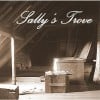Thoughts on how things might be changing
I wonder if one of the reasons visual pin boards are so popular is that some people cannot be bothered to spend long on one page. They like images and cannot be bothered to read text unless they actively searching for information.
In which case, I am left wondering what does the future look like for on-line writers and the web pages? Are pin boards to writing what fast food chains are to a carefully prepared meal? Maybe people like to graze rather than feast.View duration suggests that some people really do read from beginning to end.
I just think that most people are more visual. If the photos are controversial, beautiful, extreme depiction of realities, the more it will catch the eye. We have short attention span and most people just look at the headlines, photos and read the captions that go with it.
But for those who are really interested in one subject area and it is educational for them, I think they will read it thoroughly.
I think that it is possibly one of the side effects of the internet, after all why read a long book or article when you can get information in bite size chunks? It has long term implications on how people think and process information, and the ability to concentrate on one task for lengthy periods could be one of the casualties.
Not particularly good news for those of us who want to write, and are not that interested in sticking pretty pictures on a board. Are good writers losing out to those who are good at visuals?- kelleywardposted 13 years ago
0
I think what you are suggesting is a real possibility. However, there are still lots of people who do look to the internet to learn more about issues, buying guides, etc. Maybe we online writers need to look for ways we can learn to use visual pictures as a way to keep the reader interested in what we are trying to say. Your question is an interesting concept to consider.
I think that people still read text if it is the information they are looking for. I do. However, I also search images first sometimes, usually to help me locate the 'right' article more quickly, if that makes sense. Travel, for instance - I want an article but I want a lot of images too.
Few random thoughts..
Facebook just bought Instagram for one billion.
HP redesign puts emphasis on pictures.
Pinterest is very popular.
Lolcats and Youtube generate massive traffic.
As yet Google 'reads' text for it's search engine. I wonder if it could ever 'read' a picture and determine what it is about, whether it's funny, sad, etc and use that for indexing?
My stuff is amateur ego centric garbage with no idea about marketing, sales and so on. So I can't offer an 'expert' opinion on traffic. But I certainly have put as much, if not more, effort into pictures as text over the last few months.
Reasons being -
- images get indexed and generate some search traffic.
- people preview or scan pages first - get those ads out of the way and offer something interesting / attractive / different to look at.
- I like the text and image pages on the net, rather than just text.Thank you for sharing your thoughts on this. I think it is a real challenge to keep up with what is wanted by readers or 'viewers'.
This first became interesting to me when I began to think about the different ways different age groups approach using the internet and communicating.
The younger users have never known a world where they could not keep in touch constantly. They have never had to go into town to the library to do research when they want information. They are constantly able to communicate with one another. All of this must be changing the way that over the years that we think, interpret and use the information in the things we read or view. Now you can always re-access the information so there is no need to read it and remember the information in the same way. Which would lead to spending less time reading.
Pin boards could also be a way of 'virtually owning something' rather than actually buying it.
I have always liked making my pages look good when building them. I think the thing for me now is to find a balance between the quantity of words and images and trying to make both appealing.Yup I back your statement about libraries for research - I've never done it and I've always used the internet to get all the info I needed.
One of HP's features that could be a powerful tool in encouraging short-attention-span readers is the photo slide show. Not too long ago, HP enhanced the slide show to include both the photo capsule title and the caption in the slide show views. With planning, the slide show can summarize the content of a hub in words and pictures, acting something like an illustrated table of contents or even a "trailer," depending on how you construct it.
I think this feature has possibility for encouraging the more visual or less-focused visitor. Such a visitor could opt to view the slide show (an invitingly organized and visual content map) to find out whether he wants to read the text. Even if he doesn't read the text, he's at least absorbed the essence of the hub and has spent some time on the page.
The way the feature works now, there are a few obstacles in optimizing this quick-bite approach, among them that slide shows require a minimum of 5 photos, videos aren't included in the show, and the concept of using the slide show in this way isn't promoted (yet) by HP.
What do you think?
You said, "Maybe people like to graze rather than feast." I think so.
This is a brilliant idea. I've been checking the real time analytics at Google Analytics and have noticed that quite a few people view the slideshow. But, none of my pics have detailed descriptions or any noteworthy caption - maybe it's time to add some.
One thing I haven't done yet is design a hub based on this technique. I've only been slowly retrofitting my existing hubs, as in, as you say, adding titles and detailed captions. Glad you think it's a good idea.

Also, I've been adding more pics and videos to my hubs. I've done it on a few of the best performers and my traffic in April is much much higher than previous months. It's been a steady climb since April 1st when I began adding stuff. My traffic from about 70 views a day is now averaging 150 - pretty good increase even though the amount is still low.
I've been busy got my exams and projects, assignments and stuff so will be continuing the modifications from the 20th. Will let people know how it works out on 1st May. Hopefully by then I'll complete all.I have just had a look at this feature and it has lots of potential to adapt and update older hubs. I think it will be useful in several ways when making new pages, thank you for pointing it out.
Good luck with those exams lobobrandon and with the hub traffic too.
The sheer smount of stuff flying at us from the internet means people are continually reaching for shortcuts. They're only going to read something long if it really engages their attention and speaks to them; otherwise, they'd rather get what they need and get out. This means that it's no longer enough to be a moderately decent writer on the web-- we are long past the early days when there was't much good content on most topics. Supply of content has now outpaced demand by an order of magnitude.
That puts us back to the model we had pre-web, except that instead of the expense of publishing making it impractical to publish everything, instead, it costs little to publish, but the audience may not come to our stuff because someone else's stuff is better or appears better. The demand is out there, but we can't ALL satisfy it. If we want to succeed, it's no longer enough to write on what you want; you also have to study what the audience wants and give it to them, whether that's videos, images, or other media, or the answer to a problem.
All that aside, I think this comment is hugely insightful:
I think you're right, considering video game emphasis on getting stuff (sometimes called "loot")I think that there are more surfers on the net via PDAs,Tablets and phones than there were in the last two years. Numbers grow every time the big 3 launch a new piece of tech for mobile users.
So the question we may ask is, is our content easily read on a handheld device.
But yes, we will still get the pc user who tends to read a little more than most.
Are the numbers recorded by HP and Analytics a true reflection of the type of traffic we receive.
This may explain the image searcher numbers growing.
Just my two cents.
Great points form all though.Enlightened post.This is encouraging as the comments here are confirming the lines I have been thinking along.
The PDAs,Tablets, phones and apps (some things that I have not even begun to understand) are part of a percentage of on-line users everyday lives.
You see people in the supermarket using their phones to check ingredients for recipes.
In relation to this I can recall viewing a web page that showed you how much of a site showed up on different types/sizes of screens. In blogger you can view what your page looks like in a mobile version - which got me thinking about this. It is no good having material if the audience cannot view it, so we may have to change the way we display work as things evolve.
The virtually owning something could fit with lots of trends -
the need to cut expenditure on luxuries.
Also the taking longer to get to the point of purchasing something, you collect virtual images of it and it is like a 'I want one of these shopping list' that you will refine in time until you make your final decision on which one you will purchase. This has a special term the moment when the decision to buy is made, cannot recall it begins with a Z - maybe it zero moment of truth.
It is all a little bit strange, can you remember in Star Trek where they could enter a room that could create the virtual world of their choice to live in for a while?
Added - it is ZMOT - I found a link about it. http://www.zeromomentoftruth.com/I never knew you could use the slide show in that way, thank you Sally's Trove.
I will edit some of my travel pages to use it.It depends on the subject matter, whether people are looking more for images or written text. Each category is different.
In some categories, a picture says volumes, but in others the text gives the information readers are looking for. There needs to be a balance to a site to keep ALL readers interested.
This is why I see an all-site-wide format as the Pinterest layout as a bad idea. Some categories will benefit from this. There are others I only see losing from it. The categories that provides text information to the readers who do read, will get distracted from extra images and smaller text area.
A balance in the site would be better with the layout not forced site-wide.Changes will also come in the form of mobile. Online searchers want information to suit their needs quickly. Will mobile internet searches mean less need for full text? There will certainly be a need for text.
Related Discussions
- 5
slide show ignores some of my photos??
by cascoly 15 years ago
checked faq, help center et al but couldnt find anything related to these 2 'features':I just noticed that the slide show does noit include all f the photos i have in a hub. It looks like it's skipping the panorama images??also, the images i've uploaded appear fuzzier than they should be,...
- 11
How to Not Make a Substandard Hub on Hubpages
by Mikeydoes 14 years ago
Well I decided to make a simple little layout to hopefully help some people out.It is clear videos are the future, and the lack of videos on this site is actually kind of embarrassing. Content is key and we should be using every available resource that we have here.My Hubs all certainly can be...
- 26
hubs better with or without photos?
by optimus grimlock 14 years ago
Since the changes I've had 20 hubs taken down because of pixaled photos. It doesnt matter how many sources I use it's still the same result. For these hubs I've taken the photos off will this hurt the traffic or not really?
- 90
What have people learned about gaining traffic
by Paul Edmondson 13 years ago
I had a conversation with a new online writer and I realized what I recommended is a bit more specific than I used to be based on what I've seen be successful. I'm in the middle of refreshing several Hubs (150 to go), but here is what I tell others and am trying to do myself.- write on...
- 53
Can someone please explain pinterest to me?
by TessSchlesinger 6 years ago
Thanks Tess. I am also at a loss to understand it even though I've tried to follow the instructions. I've posted a few things that I think are links on Pinterest but I'm not sue anybody sees them. I shall await with eager anticipation the input of social media gurus.
- 25
Traffic Co-Operative - Anyone interested in this idea?
by George Poe 15 years ago
Hi all...I've been using social media to promote my hubs for some time with reasonable success and have come upon something which I want to throw out there to see what comes back;Social media as we all know is about sharing quality content and NOT about self promotion; great when you are earning a...

















